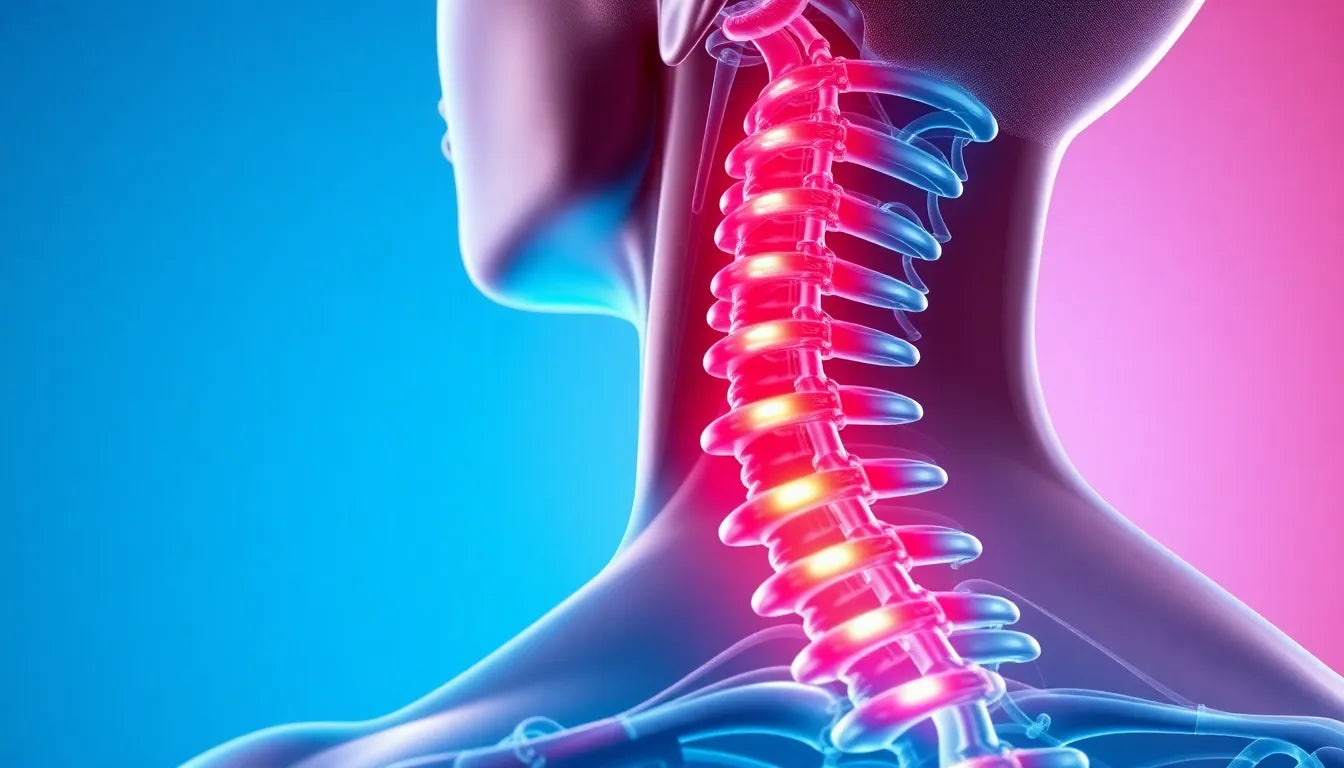Understanding the complexities of a herniated disc is essential for those seeking relief from this common spinal condition. A herniated disc occurs when the soft, gel-like center of a spinal disc pushes through a crack in the tougher exterior casing. This can irritate nearby nerves, leading to pain, numbness, or weakness in an arm or leg. Common causes include age-related wear and tear, sudden heavy strain, or even a traumatic injury. The prevalence of herniated discs is notable, affecting a significant portion of the population, particularly those over 30. This condition can severely impact daily life, limiting mobility and reducing the ability to perform everyday tasks comfortably.
The impact of herniated discs on daily life
The symptoms of a herniated disc can vary widely, from mild discomfort to severe pain that disrupts daily activities. Individuals may experience shooting pain down the legs, often referred to as sciatica, or in the arms, depending on the location of the affected disc. The impact on mobility can be profound, making it difficult to sit, stand, or walk for extended periods. This can lead to a decrease in quality of life, as individuals may find themselves unable to participate in activities they once enjoyed. Understanding the importance of finding effective relief and treatment options is crucial for those affected by this condition.
The goal of treatment for herniated discs
The primary objectives of treatment for a herniated disc are to alleviate pain, restore function, and prevent further injury. Achieving these goals often requires a multifaceted approach, as no single treatment is universally effective. A variety of treatments are available, ranging from conservative methods like physical therapy and medications to more invasive surgical options. The choice of treatment depends on the severity of the condition, the patient's overall health, and their personal preferences.
Conservative treatments are typically the first line of defense, focusing on reducing pain and inflammation while promoting healing. Physical therapy plays a crucial role in improving flexibility and strengthening the muscles that support the spine. Medications, including over-the-counter pain relievers and muscle relaxers, can help manage pain and discomfort. In some cases, epidural steroid injections may be recommended to provide targeted relief.
For those whose symptoms do not improve with conservative measures, surgical options may be considered. Surgery aims to remove or repair the herniated portion of the disc, relieving pressure on the nerves and restoring function. However, surgery is typically reserved for cases where conservative treatments have failed or when neurological symptoms are severe.
Ultimately, finding the right treatment for a herniated disc involves a combination of medical guidance and personal preference. By understanding the condition and exploring the various treatment options available, individuals can take proactive steps toward finding relief and improving their quality of life.
conservative treatments for herniated discs
When it comes to managing a herniated disc, conservative treatments are often the first step. These non-invasive options aim to alleviate pain and improve function without the need for surgery. One of the most effective conservative treatments is physical therapy. Physical therapists work with patients to develop customized exercise programs that focus on improving flexibility and strengthening the muscles supporting the spine. Common exercises include stretching routines, core strengthening, and low-impact aerobic activities such as swimming or walking. These exercises not only help to alleviate pain but also promote healing by increasing blood flow and reducing inflammation.
In addition to physical therapy, medications play a crucial role in managing the symptoms of a herniated disc. Over-the-counter pain relievers, such as nonsteroidal anti-inflammatory drugs (NSAIDs), are often recommended to reduce pain and inflammation. In some cases, muscle relaxers may be prescribed to relieve muscle spasms associated with the condition. When over-the-counter options are insufficient, healthcare providers might prescribe stronger medications to manage severe pain.
epidural steroid injections and lifestyle modifications
For individuals who experience persistent pain despite initial conservative treatments, epidural steroid injections can offer significant relief. These injections deliver corticosteroids directly into the epidural space around the spinal nerves, reducing inflammation and providing targeted pain relief. The procedure is typically performed under imaging guidance to ensure precise placement of the medication. While the effects of epidural steroid injections can vary, many patients experience relief that lasts from several weeks to a few months, allowing them to participate more actively in physical therapy and other rehabilitation efforts.
Weight loss and lifestyle modifications are also critical components of conservative treatment for a herniated disc. Excess body weight places additional stress on the spine, exacerbating symptoms and potentially hindering recovery. By adopting a balanced diet and engaging in regular physical activity, individuals can reduce spinal pressure and enhance their overall health. Lifestyle changes, such as quitting smoking and practicing good posture, can further support healing and prevent the recurrence of disc herniation.
alternative therapies for herniated disc relief
In addition to traditional conservative treatments, alternative therapies like acupuncture and chiropractic care can provide complementary relief for individuals with a herniated disc. Acupuncture, an ancient Chinese practice, involves inserting thin needles into specific points on the body to stimulate the nervous system and promote healing. Some studies suggest that acupuncture may help reduce pain and improve function in patients with herniated discs, although results can vary from person to person.
Chiropractic care is another alternative therapy that some patients find beneficial. Chiropractors use spinal manipulation techniques to align the spine and relieve pressure on affected nerves. While chiropractic care is not suitable for everyone, it may be an option for individuals with mild to moderate symptoms who have not found relief through other conservative treatments. It is essential to consult with a healthcare provider to determine the safety and appropriateness of chiropractic care for each individual case.
Ultimately, the path to relief from a herniated disc is highly individualized, and exploring a combination of these conservative and alternative therapies can help patients find the most effective solution for their unique situation. By working closely with healthcare professionals and considering all available options, individuals can take significant steps toward reducing pain, improving function, and enhancing their quality of life.
Surgical options for herniated discs
For some individuals, conservative treatments may not suffice, and surgical intervention becomes a necessary consideration. Surgery for a herniated disc is typically reserved for cases where non-surgical methods have failed to provide relief, or when neurological symptoms such as significant weakness or loss of bladder control present a serious concern. The decision to proceed with surgery is made after careful evaluation of the patient’s condition and overall health.
Discectomy
Discectomy is one of the most common surgical procedures for treating a herniated disc. It involves the removal of the herniated portion of the disc that is pressing on the nerve root. The primary goal of a discectomy is to relieve nerve compression and alleviate pain. This procedure is often performed using minimally invasive techniques, which can result in shorter recovery times and less postoperative discomfort.
Spinal fusion
Spinal fusion may be recommended when there is spinal instability or when multiple discs are involved. This procedure involves fusing two or more vertebrae together to stabilize the spine. While spinal fusion can effectively reduce pain and prevent further disc herniation, it does limit some range of motion in the spine.
Artificial disc replacement
For select patients, artificial disc replacement offers an alternative to spinal fusion. This procedure involves replacing the damaged disc with an artificial one, allowing for the preservation of more natural spinal movement. Candidates for this surgery are typically younger patients with isolated disc issues and no significant spinal instability.
Laminotomy
Laminotomy is a procedure used to relieve pressure on the spinal nerves by removing a small portion of the bone or ligament overlying the spinal canal. This approach can be beneficial in cases where nerve decompression is necessary to alleviate symptoms. Like other surgical options, laminotomy is usually considered after conservative treatments have been exhausted.
Frequently asked questions
What is the success rate of non-surgical treatments for herniated discs?
Non-surgical treatments for herniated discs have a high success rate, with many patients experiencing significant pain relief and improved function. Studies indicate that up to 90% of individuals with a herniated disc improve with conservative management, including physical therapy and medications, within six weeks to three months.
How long does it take to recover from a herniated disc?
Recovery time from a herniated disc varies depending on the severity of the condition and the treatments used. Many patients experience relief from symptoms within a few weeks to a few months with conservative treatment. Surgical recovery can take longer, with most patients returning to normal activities within six weeks to three months, depending on the procedure.
When should I consider surgery for a herniated disc?
Surgery should be considered when conservative treatments have not provided sufficient relief, or if there are severe neurological symptoms such as significant weakness, loss of bowel or bladder control, or persistent pain that interferes with daily activities. Consultation with a healthcare professional is essential to determine the best course of action.
Can lifestyle changes alone manage a herniated disc?
While lifestyle changes such as weight management, regular exercise, and ergonomic adjustments can significantly impact managing a herniated disc, they may not be sufficient alone for everyone. These changes are most effective when combined with other treatments like physical therapy and medications.
Are alternative therapies like acupuncture effective for everyone?
Alternative therapies such as acupuncture can provide relief for some individuals with a herniated disc, but their effectiveness varies. These treatments are often used as complementary options alongside conventional methods. A personalized approach, guided by a healthcare provider, is crucial to determine the most suitable therapies for each individual.
Sources
- NYU Langone Health. "Nonsurgical Treatments for Herniated Disc."
- MidAmerica Orthopaedics. "Conservative and Surgical Treatment Options for Herniated Discs."
- WebMD. "Herniated Disk Treatment, Remedies, and Medications."
- Froedtert & Medical College of Wisconsin. "Herniated Disk Treatment Options."
- Cuéllar Spine. "Herniated Disc Treatment Options."


















